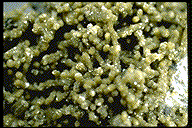

- Chemistry: MgAlBO4 , Magnesium Aluminum Borate.
- Class: Carbonates
- Subclass: Borates
- Uses: An a gemstone and as mineral specimens.
Specimens
Sinhalite is rare mineral and known only from the gem gravels in Sri Lanka. It was thought to be a brownish variety of the normally green peridot, the gem variety of olivine. It was first discovered to be a new species in 1952 when an unusually dark brown specimen came under scientific scrutiny. Since then it has been an unusual gemstone, being a member of the borates. Because it is so rare, has few notable characteristics to give it distinction and the not too overwhelming demand for brownish green gemstones; sinhalite has not enjoyed much success on the gemstone markets and is usually sought after only by collectors of rare and unusual gemstones. Sinhalite gets its name from sinhala, the Sanskrit word for the island of Ceylon, now known as Sri Lanka.
PHYSICAL CHARACTERISTICS:
- Color is greenish brown to brown, sometimes greenish-yellow.
- Luster is vitreous.
- Transparency: Crystals are transparent to translucent.
- Crystal System is orthorhombic.
- Crystal Habits are quite limited to alluvial grains found in gem gravels.
- Cleavage is distinct in two directions.
- Hardness is 6.5
- Specific Gravity is approximately 3.5 (slightly above average for translucent minerals)
- Streak is white.
- Other Characteristics: strongly pleochroic, meaning it may appear to have different colors from different viewing angles.
- Associated Minerals are other gem gravel minerals such as
ruby ,sapphire , peridot and garnets. - Notable Occurrences are limited to the gem gravels of Sri Lanka.
- Best Field Indicators are color, locality, pleochroism and the relatively high hardness.








